This Soondubu Jjigae recipe will give you a delicious and easy Korean spicy soft tofu stew made with an anchovy broth. It’s loaded with pork and shrimp for the best kind of comfort food out there! If you’ve always wanted to make a delicious Korean dish, then this is the one you need to try!
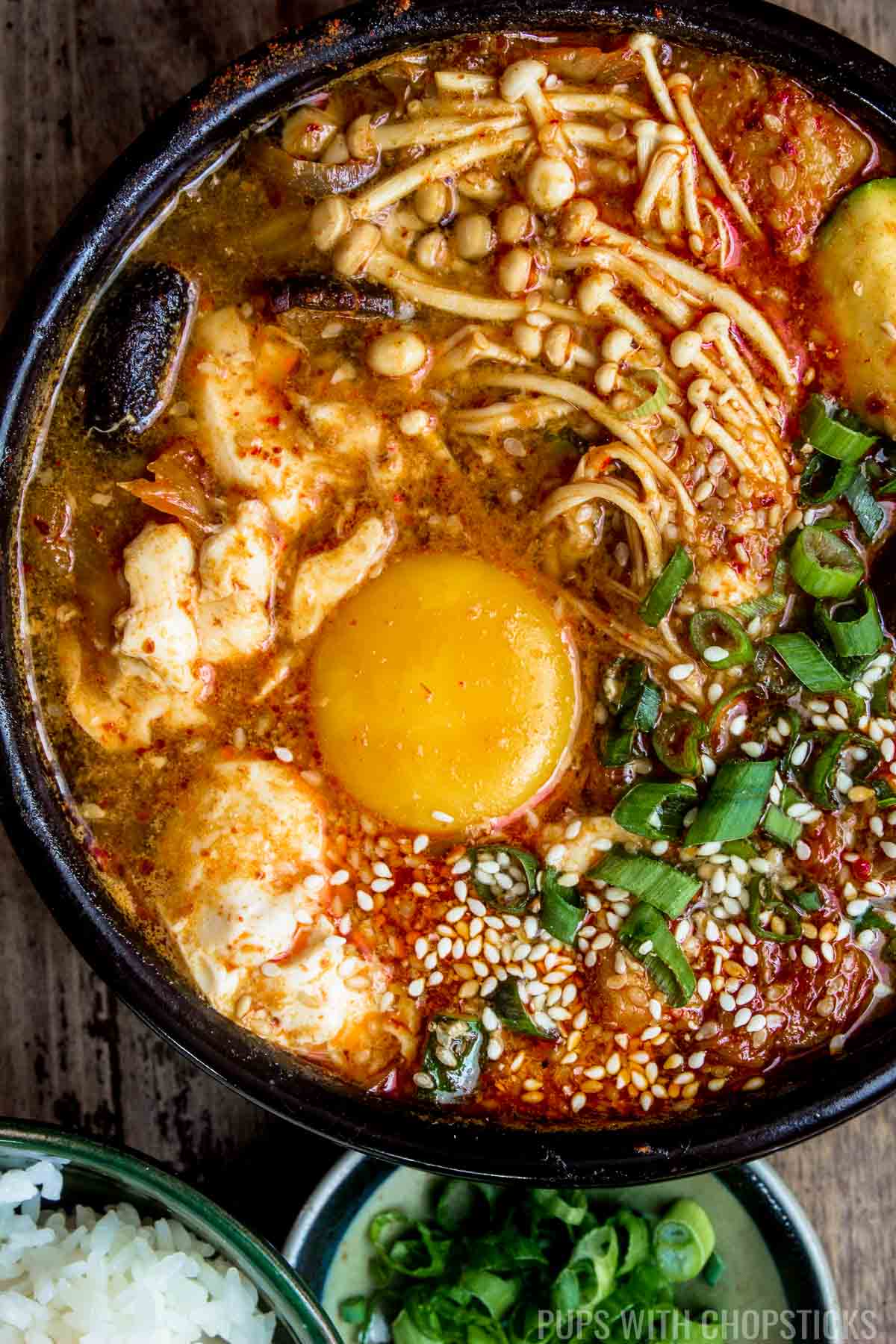
Table of Contents
- What is Soondubu Jjigae?
- Korean Earthenware Bowls
- Why You’ll Love This Soondubu Recipe
- Ingredients You’ll Need to Make Soondubu Jjigae
- How to Make Soondubu Jjigae (Step by Step)
- Joyce’s Tips For Making the Best Soondubu
- Anchovy Stock Variations
- Serving Suggestions
- Recipe Variation Ideas for Soondubu Jjigae
- Frequently Asked Questions
- How to Store Leftover Soondubu
- Recipes To Use Up Leftover Kimchi
- More Korean Recipes You May Like
- Did You Make This Recipe?
- Recipe Card
- More Cozy & Comforting Recipes to Try
Soondubu (sundubu) is a traditional spicy Korean silken tofu stew that’s made with savory ingredients such as anchovy broth, kimchi, pork belly, and soft tofu. The great thing about Soondubu is its versatility. You can easily customize it to your liking, making it a great dish to whip up in your kitchen at home.
If you're looking for something similar to this tofu stew and just as cozy, I recommend trying my Tteokbokki (Spicy Korean Rice Cakes) recipe that can be ready in 30 minutes or less and has that satisfying chew that all rice cakes have.
Read on to learn exactly how to make this delicious soondubu recipe today!
What is Soondubu Jjigae?
Soondubu, also known as Sundubu Jjigae or soft tofu stew, is a staple Korean dish that is both hearty and comforting. This popular recipe is essentially a spicy stew made from silken tofu and various vegetables and often includes meat and seafood. It’s typically served with rice on the side to balance out the heat and absorb the flavorful broth.
Traditionally, it’s made and served in an earthenware stone bowl, which insulates the stew and keeps it very hot longer, so you can enjoy the stew slowly with a bowl of rice.
Soondubu Jjigae is a perfect dish to make at home because it is a one-pot recipe, making it convenient and easy to clean up. When it comes to taste, this dish truly delivers. The soft tofu, combined with the rich, spicy broth, creates a delightful contrast of textures and flavors.
Nothing truly beats a hot, hearty stew on a chilly day and when it's served in a sizzling hot pot with freshly cooked rice. This is the ultimate comfort food, with hearty flavors to lift your spirits. Trust me, you’re going to love this Korean stew!
Korean Earthenware Bowls
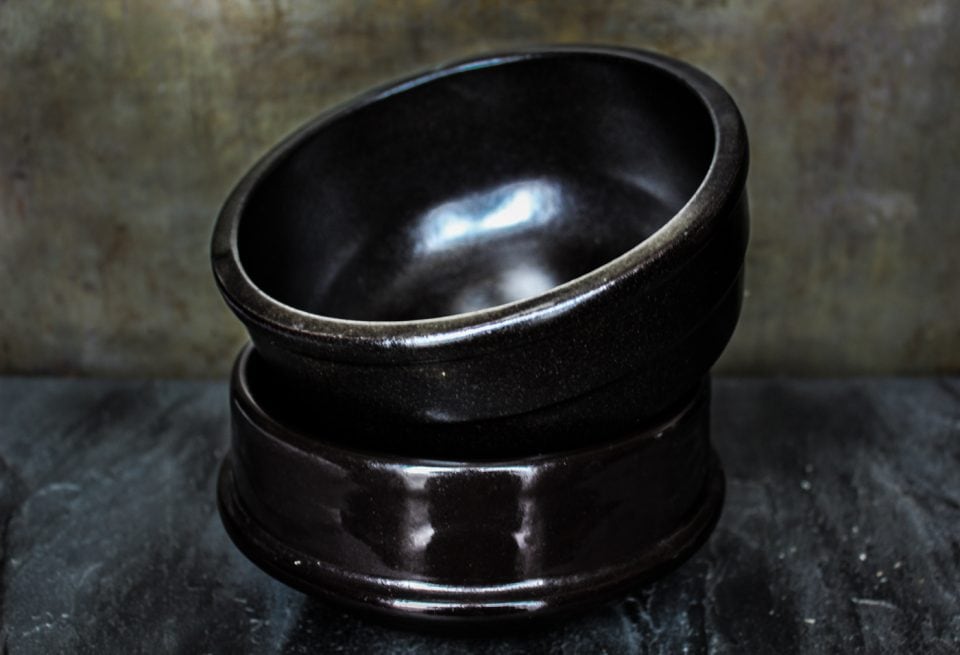
Traditionally, soondubu is cooked and served in Korean earthenware stone bowls called ttukbaegi. These Korean stone bowls are thick (approximately ½ inch thick) and can retain heat to keep your soups and stews hotter, and longer.
If you can't find these bowls you can use a regular pot. The only difference is you may need to adjust the cooking time because the recipe will cook a lot faster since regular pots are thinner.
Why You’ll Love This Soondubu Recipe
Classic Delicious Flavors: Loaded with flavorful ingredients like pork, shrimp, and kimchi and served over warm rice, this soft tofu stew is a dish that the whole family will love. Plus, it is a great way to introduce them to Korean cuisine.
Versatile: This recipe is adaptable to suit your personal preferences. Not a fan of pork or shrimp? Swap them out for your preferred protein. You can even adjust the spice level to your liking. The possibilities are endless!
Crowd Pleaser: Whether you're hosting a dinner party or bringing a dish to a potluck, this soft tofu stew is sure to impress. It is a unique dish that stands out from the usual fare, but it’s also familiar and comforting, making it a hit with just about everyone!
Warm and Cozy Meal: This is the perfect cozy meal, and is especially great on colder seasons like Autumn and Winter. If you are looking for the ultimate comfort food, this would be it.
Ingredients You’ll Need to Make Soondubu Jjigae
All you need are some incredibly simple, pantry-staple ingredients to make this delicious soondubu recipe at home.
Here's an overview of the specific ingredients for this recipe. For the exact ingredients and measurements, please scroll to the recipe card below.
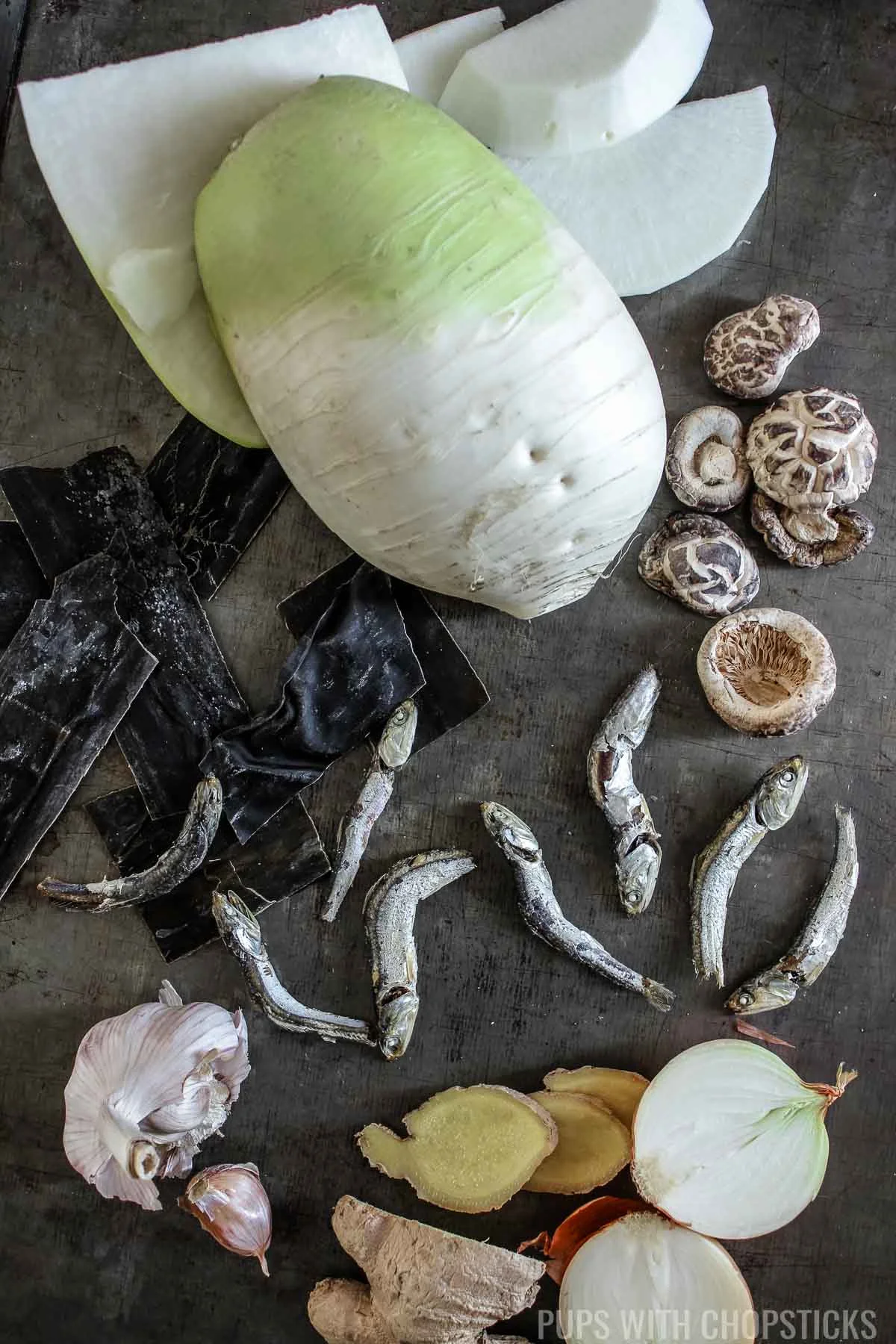
For the Broth:
- Korean Radish: This optional ingredient adds a unique sweetness to the broth. If you can't find it, you can replace it with a daikon radish. Keep in mind that Korean radishes are sweeter and have a milder radish flavor. They are thicker in size and have a more prominent greenness at the top half.
- Ginger: Gives a subtle spicy flavor to the broth, enhancing its overall taste.
- Dried Anchovies: They are the backbone of the broth, providing a deep umami flavor. You can replace them with a dashi stock or pre-made broth for a quicker stew. These are dried and can usually be found in the refrigerator section in Korean supermarkets, not to be confused with the anchovies in oil. Remove the heads before you use them.
- Garlic: Adds a strong, spicy, garlic flavor to the broth.
- Shiitake Mushrooms: These mushrooms are used in both the broth and the stew. They add a meaty and earthy flavor, enhancing the overall dish. In this recipe, I used dried ones, which require a good rinse, and 10-15 minutes of soak time in cold or warm water. Fresh shiitake can be used as well and will produce an even more flavorful broth.
- Kelp: This is used in the broth to add an extra umami flavor to the broth. No need to soak it ahead of time. You can rinse it over the sink and put it directly in the broth.
For the Soondubu Sauce:
- Fish Sauce: This is used in the Soondubu sauce to provide a deep umami flavor. Soy sauce can also be used as a substitute.
- Garlic: It adds a delicious, savory, and spicy flavor to the sauce that takes it to the next level.
- Korean Red Pepper Flakes: They add a spicy kick to the Soondubu sauce. Korean chili flakes are usually found in the dried spices aisle. You can buy this mild or spicy. If you don't know if it's spicy, ask the store clerk for some help. Make sure you are not getting goun gochurgaru, which is a finer powder that is used to make gochujang.
- Sesame Oil: Adds a nutty flavor to the Soondubu sauce.
- Sugar: Balances out the spicy and salty flavors in the sauce.
- Sesame Seeds: These are used in the sauce and also as a garnish. They add a slight crunch and a nutty flavor.
- Cooking Sake: This rice wine adds a bit of sweetness and complexity to the sauce.
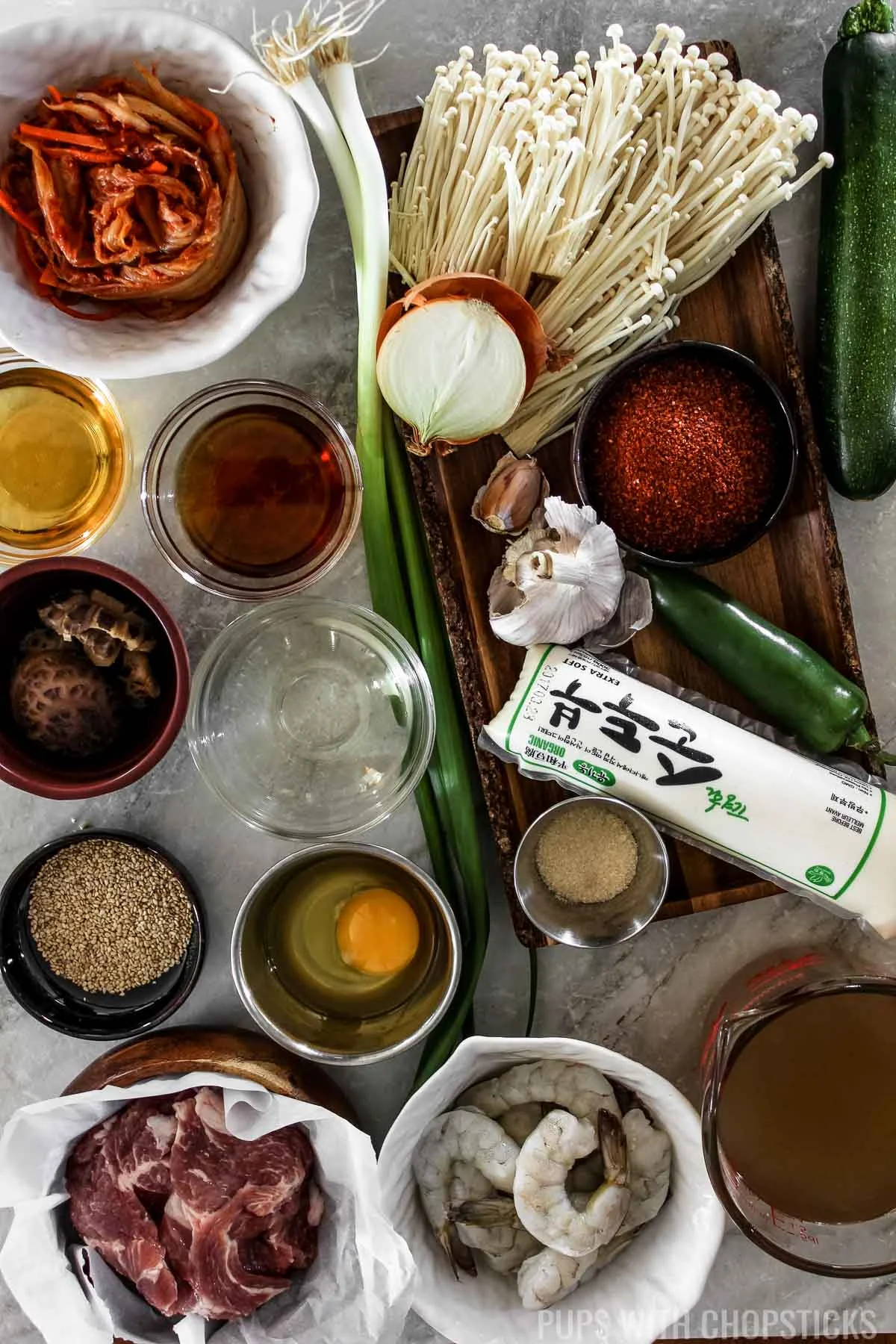
For the Stew:
- Onion: Used in the broth and stew, onion adds a sweet flavor that compliments the spicy and savory elements of the dish.
- Pork: This meat adds a hearty and savory flavor to the stew. I like to use pork belly for this soondubu stew, but you can also use pork shoulder or pork butt slices as well.
- Shrimp: An optional ingredient that lends a sweet and slightly briny taste to the stew and a delicious bite. You can replace the pork belly in this recipe and use any type of seafood as well, such as scallops, squid, oysters, mussels, or clams.
- Kimchi: This fermented cabbage adds a tangy, spicy, and umami flavor to the stew.
- Soondubu (Silken Soft Tofu:) The star of the dish, this tofu is silky and soft, absorbing all the flavors of the stew. Traditionally, soondubu is made with silken tofu which comes in a tube. It is softer in texture than the traditional and more common square soft tofu you can find at regular grocery stores. That being said you can definitely still use the traditional square soft tofu for soondubu - just make sure it's soft and not medium or hard tofu.
- Zucchini: Adds a refreshing crunch and lightness to the heavy stew.
- Enoki Mushrooms: These mushrooms add a unique texture and a mild flavor to the stew.
For the Garnishes:
- Eggs: A raw egg is cracked into the stew just before serving. If you're not a fan of raw egg, you can fry a sunny-side-up egg and add that on top instead!
- Green Onions: Used as a garnish, they add a bright, fresh flavor and color to the stew.
- Toasted Sesame Seeds: They are used as a garnish, adding a slight crunch and a nutty flavor to the finished dish.
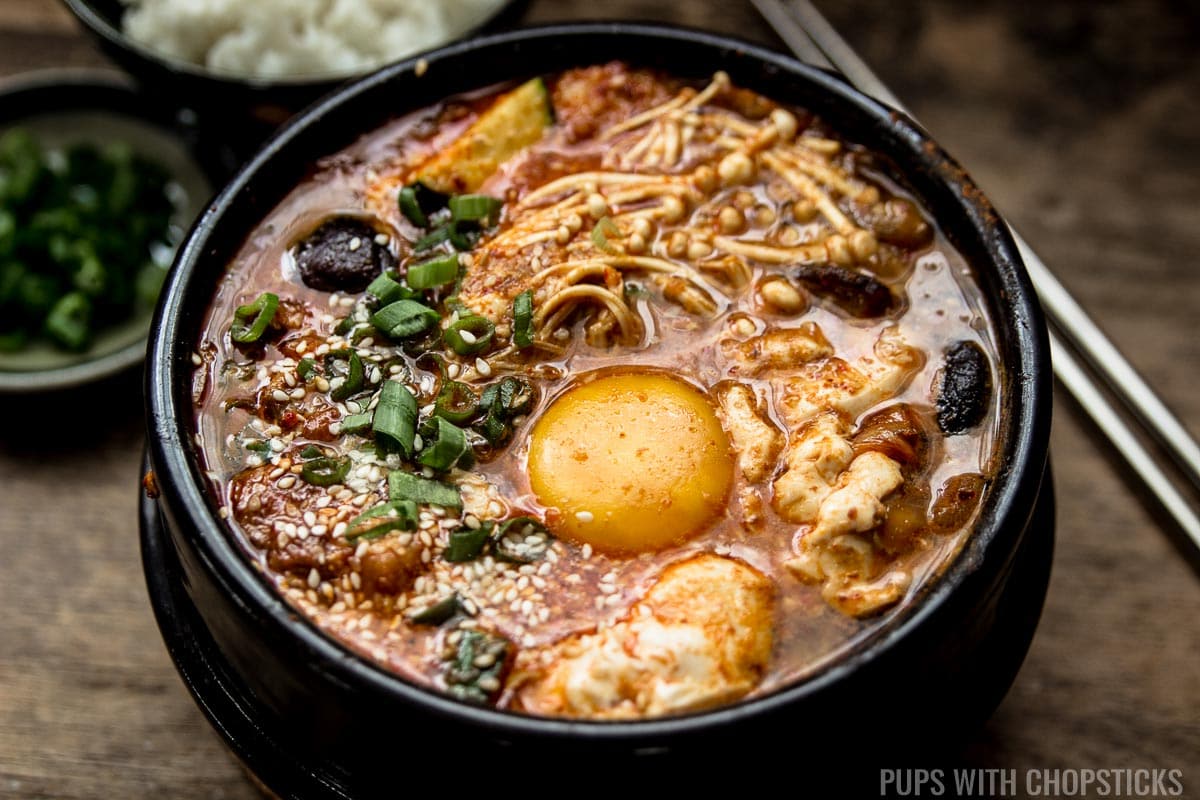
How to Make Soondubu Jjigae (Step by Step)
Making this incredible soondubu recipe at home is super easy and will give you great results every single time. Here's how to make it step by step:
Making the Broth
Prepare your Ingredients: Start by removing the heads from your dried anchovies and discard the heads.
Slice a one-inch piece of Korean radish into half-inch pieces, and set aside.
Soak five shiitake mushrooms in warm water for about ten to fifteen minutes.
Slice a piece of ginger and set it aside. Peel three cloves of garlic, keep them whole and set them aside.
Peel and cut half an onion and set it aside.
Lastly, cut a four-inch piece of kelp and set it aside.
Boil your Broth Ingredients: In a pot, combine three cups of water, your prepped Korean radish, ginger, onion, dried anchovies, garlic, shiitake mushrooms, and kelp. Bring this to a boil on medium heat with the lid on for approximately twenty to thirty minutes.
Strain your Broth: Once your broth is done, strain out the ingredients but keep the shiitake mushrooms. Cut them into smaller pieces for the stew. Set the broth and shiitake aside. Alternatively, you can use a pre-made broth as a shortcut.
Preparing the Main Ingredients
Slice your Pork and Vegetables: Slice half a pound of pork belly into small bite-sized pieces and set aside. Also, slice half an onion and half a zucchini and set them aside. Optionally, you can chop a cup of kimchi into smaller pieces and set it aside.
Making the Sauce
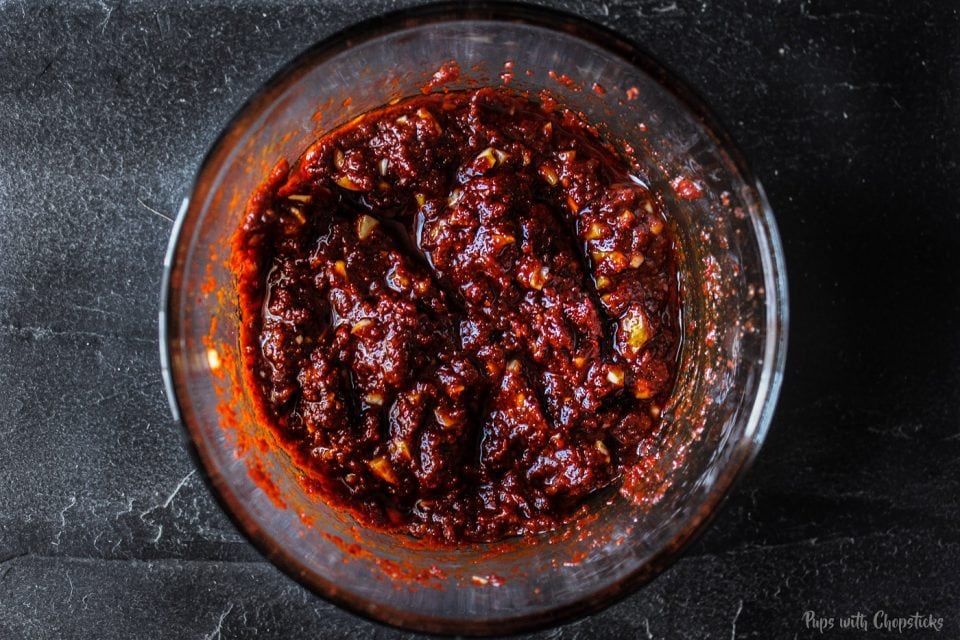
Combine your Sauce Ingredients: Finely mince cloves of garlic and add it to a small bowl. Combine this with fish sauce (or soy sauce), Korean pepper flakes, sesame oil, sugar, sesame seeds, and cooking sake (or Chinese cooking rice wine). Mix these ingredients together and set the sauce aside.
Making the Soondubu Jjigae
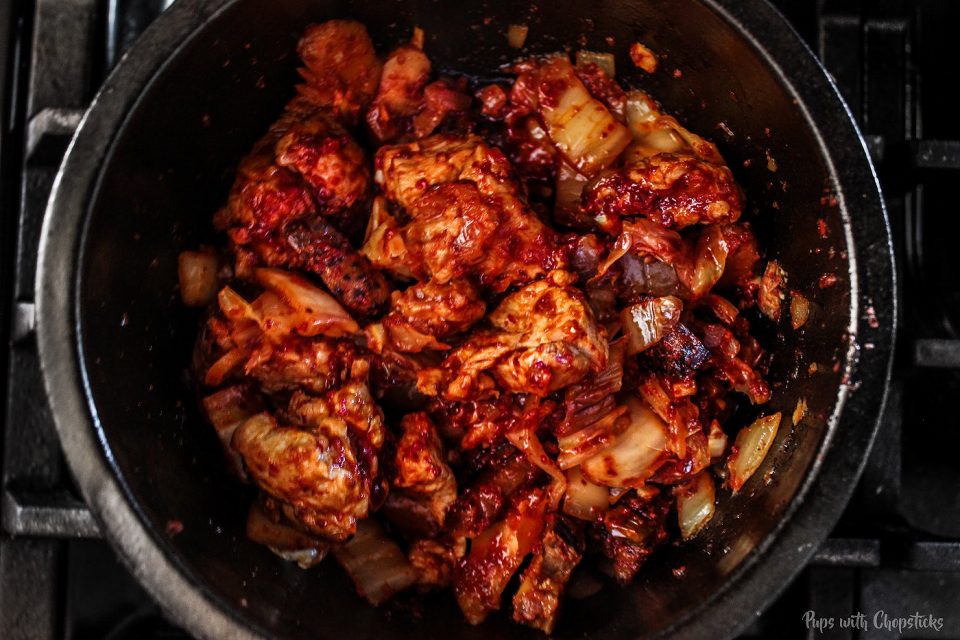
Cook your Onion and Pork: Set your stove to medium heat and place your pot on the stove. Once the pot is hot, add in oil, and cook the onion and pork belly for about five minutes or until the pork is no longer pink.
Add in your Other Ingredients: Add in the one to one and a half cups of broth, your prepared sauce, kimchi, zucchini, and shiitake mushrooms and cook for five minutes.
Add in Tofu, Mushrooms, and shrimp: Once the broth is at a low rolling boil, add in the tofu, enoki mushrooms, and shrimp. Break the tofu into large chunks gently and cook for two minutes.
Add the Egg: Gently add the raw egg on top and let it simmer for one to two minutes before turning off the heat.
Finish and Serve: Carefully remove the bowl from the stove (it will be very hot, so use oven mitts!), and garnish with green onions and toasted sesame seeds.
Serve your delicious soondubu jjigae immediately, preferably with some rice. Enjoy your homemade Korean soft tofu stew!
Joyce’s Tips For Making the Best Soondubu
Broth Shortcut: Skip the step to make the seafood broth and use pre-made broth. I also provide a few other anchovy broth variations below to make things quicker and easier.
Cut the Silken Tofu Tube in Half: If you are using the tube soft tofu, don't use the spout to remove the tofu from the packaging. Cut the tube in half down the middle and gently squeeze the tofu out that way. If you are using soft tofu (not the tube kind) then scoop large chunks into the stew instead of cutting it because it is very delicate and hard to handle.
Consider Your Garnishes: Garnishing your dish with eggs, toasted sesame seeds and finely chopped green onions not only adds to the presentation but also introduces extra flavors and textures.
Make Use of Leftover Broth: If you end up with leftover broth, don't throw it away! You can use it as a flavorful starter for other soups or dishes.
Control Your Heat: Sundubu Jjigae is best cooked at medium heat. This allows the ingredients to cook thoroughly without burning them or overcooking the tofu and shrimp.
Anchovy Stock Variations
If you are pressed for time or you don't want to make the broth from scratch, here are some other variations you can use to make this soondubu recipe even quickly
- Dashi Powder - Make a dashi stock by mixing 1 ½ cups of hot water with 1 ½ teaspoon of dashi powder (I highly recommend this method because of the extra umami and smoky flavor)
- Other Types of Broth - Use the standard pre-made broth instead. Any kind will work, you can use seafood, vegetable, chicken, or beef.
- Water - Use plain water, your soup will still turn out delicious because of the sauce and the kimchi.
- Pre-packaged Anchovy Packets - Boil 2 cups of water with pre-packaged anchovy packets for 10 minutes.
Serving Suggestions
- For a wholesome meal, enjoy a bowl of Soondubu Jjigae with a side of warm, steamed rice. The soft tofu stew, rich with flavors of sesame oil and kimchi, pairs perfectly with the plain rice.
- Want to make your Soondubu Jjigae a full meal? Serve it with assorted Korean banchan, like Pickled Daikon Radish or Korean Cucumber Salad. The tangy crunch of these side dishes compliments the soft and spicy stew beautifully.
- Another great banchan that will take this meal to the next level is some Japchae (Korean glass noodles). This vegetarian chap chae goes beautifully with soondubu jjigae.
- This delicious Soondubu also goes great with some roasted okra. The umami flavors of the glaze go beautifully with this Korean stew.
Recipe Variation Ideas for Soondubu Jjigae
This delicious soondubu recipe is so flavorful and easy to make you'll want to try out some of these delicious variations! Here are some great ideas:
Anchovy Broth Variation: If you don’t want to make the broth from scratch, you can make it using dashi stock, pre-made broth, plain water, and pre-packaged anchovy packets. Check out the notes in the recipe card for more instructions.
Sunny Side Up Egg: In case you’re not a fan of the raw egg, you can fry a sunny-side egg and add that on top instead. It’ll taste just as tasty, trust me!
Go Egg-less: If you're not a fan of raw or soft-cooked eggs, you can omit the egg from the recipe. Instead, garnish your sundubu jjigae with extra green onion for added freshness and color.
Other Garnishes: You can garnish your Korean stew with sesame seeds, hot peppers, green onions, toasted seaweed, furikake, bonito flakes, or crack a raw egg in it as instructed in the recipe.
Frequently Asked Questions
Absolutely! If you're short on time, you can use pre-made broth, dashi stock, or even plain water instead of making the broth from scratch. You can also use pre-packaged anchovy packets to flavor the water. Check out the recipe card for more details.
Yes, you can. If you're not a fan of the raw egg, you can fry a sunny-side-up egg and add that on top instead. It is just as tasty and adds a nice touch to the dish.
If you can't find Korean Stone Bowls, you can use any pot. The key is to keep the stew simmering hot when you serve it, so a small cast-iron pot would be a great alternative. If you can't find a cast-iron pot, any pot will do, it just won't keep the soup warm for a long period of time, but if you eat fast that won't matter anyway!
Absolutely! This recipe is quite flexible. You can add other vegetables like bell peppers, carrots, or spinach, depending on your preference. Just remember to adjust the cooking time accordingly to make sure that all the ingredients are cooked properly.
How to Store Leftover Soondubu
Before storing your leftover soondubu jjigae, allow it to cool down to room temperature. Once cooled, transfer it into an airtight container. It’s important to use an airtight container to keep the flavors of the stew intact and to avoid any unwanted fridge odors from seeping into your dish.
The fridge is the best place to store your leftover sundubu jjigae. It should be good for up to three to five days when properly refrigerated. When you're ready to enjoy your soondubu jjigae again, simply reheat it over medium heat on the stove.
You can also microwave it, but be sure to stir it at every 1 minute intervals to avoid drying it out and to ensure it heats through evenly.
I don’t recommend freezing this dish since the soft tofu doesn’t freeze well and can become grainy and lose its soft, silky texture.
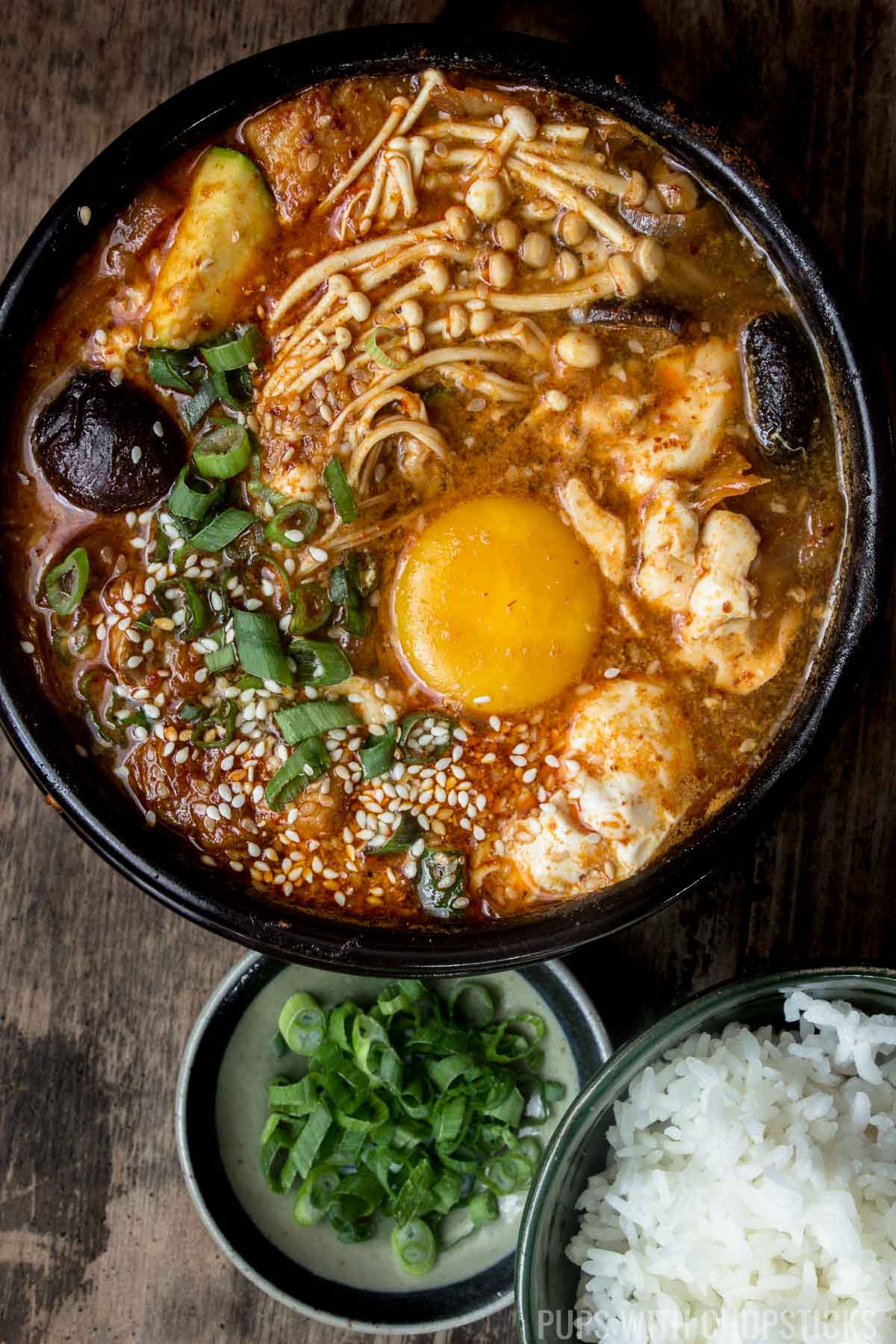
Recipes To Use Up Leftover Kimchi
More Korean Recipes You May Like
- Tuna Mayo Deopbap (Korean Tuna Rice Bowl)
- Korean Fried Popcorn Turkey
- Japchae (Korean Glass Noodles Stir Fry)
- Spicy Korean Pork Bulgogi
- Korean Corn Cheese (Elote Style)
- Korean Cucumber Salad (Oi Muchim)
- Tteokbokki (Korean Spicy Rice Cakes)
Did You Make This Recipe?
If you made this kimchi soondubu recipe, I want to see! Follow Pups with Chopsticks on Instagram, snap a photo, and tag and hashtag it with @pupswithchopsticks and #pupswithchopsticks. I love to know what you are making!
Please also consider leaving a ⭐⭐⭐⭐⭐ rating and a comment to tell me how it went! I'd love to hear from you if you made this!
If you like my recipes and want to be updated on when new ones come out, please consider subscribing to my newsletter (we don't spam) and follow along on Instagram, Facebook, and Pinterest for all of my latest recipes!
Recipe Card
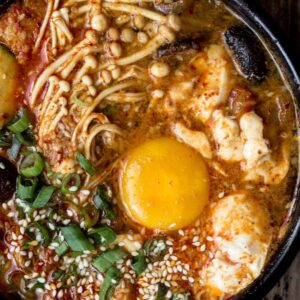
Kimchi Soondubu (Spicy Korean Soft Tofu Stew)
Equipment
Joyce's Recipe Notes
- Anchovy Broth Variations: If you don't want to make the broth from scratch, you can use these instead to make this tofu stew more quickly:
- make a dashi stock by mixing 1 ½ cups of hot water with 1 ½ teaspoon of dashi powder (I highly recommend this method)
- use pre-made broth (any kind, seafood, vegetable, chicken, or beef)
- use plain water
- boil 2 cups of water with pre-packaged anchovy packets for 10 minutes.
- If you are not a fan of the raw egg, you can fry a sunny-sided egg and add that on top instead! Just as tasty!
- If you are using the tube soft tofu, don't use the spout to remove the tofu from the packaging. Cut the tube in half down the middle and gently squeeze the tofu out that way.
- If you can't find the Korean Stone Bowls locally, you can pick them up here.
Ingredients
Broth (makes about 2 cups of broth, see notes for easier variations)
- 3 cups water
- 1 inch korean radish (Optional, cut into ½ inch slices)
- 1 slice ginger
- ½ onion
- 6 dried anchovies (heads removed)
- 3 cloves garlic
- 3 dried shiitake mushrooms (washed, if you're using the dried ones - soak in water for 10-15 minutes)
- 4 inch kelp (aka kombu)
Soondubu Sauce
- 2 tablespoons fish sauce (or soy sauce)
- 2 cloves garlic (finely minced)
- 2 tablespoons korean red pepper flakes (gochugaru)
- 1 tablespoons sesame oil
- ½ tablespoon sugar
- ½ tablespoon sesame seeds
- 1 tablespoon cooking sake (or sake, Chinese cooking rice wine)
Stew Ingredients
- ½ onion (chopped)
- ½ lb pork shoulder (sliced or cut into small chunks)
- 10 shrimp (Optional)
- 1 cup kimchi (chopped)
- 1 package silken soft tofu (sundubu, 350g)
- 5 dried shiitake mushrooms (reserved from broth)
- ½ zucchini (cut into slivers)
- ½ package enoki mushrooms (cut and remove the root bottoms)
Garnishes
- 1 eggs
- toasted sesame seeds
- 3 stalks green onions (finely chopped)
Instructions
Making the Broth
- Remove the heads from 6 anchovies and set them aside.
- Cut 1 inch of Korean radish, slice them into ½ inch pieces and set aside.
- Rinse and soak 5 shiitake mushrooms in warm water for 10-15 minutes.
- Cut 1 slice of ginger and set it aside
- Peel 3 cloves of garlic, keep it whole and set it aside
- Peel and cut ½ an onion and set it aside.
- Cut a 4 inch piece of kelp and set it aside.
- In a pot, combine 3 cups of water, Korean radish, ginger, onion, dried anchovies, garlic, shiitake mushrooms, and kelp into a pot and boil for approximately 20-30 mins on medium heat with a lid on.
- When the broth is done, strain out the ingredients but keep the shiitake mushrooms and cut them into smaller pieces for the stew. Set the broth and shiitake aside.
- [Optional Shortcut] Instead of making the broth, you can also use pre-made broth.
Preparation
- Slice ½ lb pork belly into small bite-sized pieces and set aside.
- Slice ½ onion and ½ zucchini and set them aside
- (Optional) Chop 1 cup of kimchi into smaller pieces and set them aside.
Make the Sauce
- Finely mince the 2 cloves of garlic and add it to a small bowl.
- Add 2 tablespoons of fish sauce (or soy sauce), 2 tablespoons of Korean pepper flakes, 1 tablespoon of sesame oil, ½ tablespoon of sugar, ½ tablespoon of sesame seeds, and 1 tablespoon of cooking sake (or Chinese cooking rice wine) to a small bowl and mix it with the garlic. Set it aside.
Making the Soondubu Jjigae
- Set the stove to medium heat and place the earthenware bowl or a pot on the stove.
- Once the pot is hot, add in oil, and cook the onion and pork belly for about 5 minutes or until the pork is no longer pink.
- Add in the 1-1½ cups of broth, sauce, kimchi, zucchini, and shiitake mushrooms and cook for 5 minutes
- Once the broth is at a low rolling boil, add in the tofu, enoki mushrooms, and shrimp. Gently break the tofu into large chunks and cook for 2 minutes
- Gently add the raw egg on top and simmer it for 1-2 minutes and turn off the heat.
- Remove the bowl (be very careful it's very hot! Wear oven mitts!) from the stove and garnish with green onions and toasted sesame seeds.
- Serve immediately and enjoy with some rice!
Nutrition
*Nutritional information is calculated using online tools and is an estimate*
Disclaimer: We are a participant in the Amazon Services LLC Associates Program, an affiliate advertising program designed to provide a means for us to earn fees by linking to Amazon.com and affiliated sites, however I provide these links to make items easier to find if you cannot purchase this locally and I would never recommend anything I don’t own myself or highly recommend. I would prefer you buy your items locally if possible to support your local shops (and chances are they are cheaper locally as well!)
More Cozy & Comforting Recipes to Try
- Chinese Tomato Egg Stir-Fry 番茄炒蛋 (Authentic Easy Recipe)
- Sweet & Smoky Pineapple Chipotle Chili
- Three Cup Chicken (三杯鸡, Taiwanese San Bei Ji)
- Bo Kho (Vietnamese Beef Stew)
- Chicken Khao Soi Recipe (Thai Coconut Curry Noodle Soup)
- Miso Red Wine Braised Lamb Shank Recipe
- Bangers and Mash + Stout and Onion Gravy
- Beer Braised Pork Belly (Chinese Style)


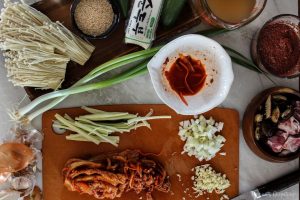
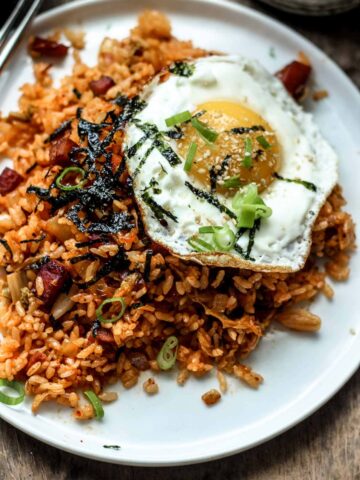
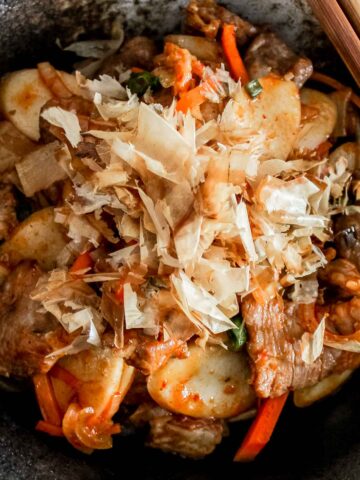

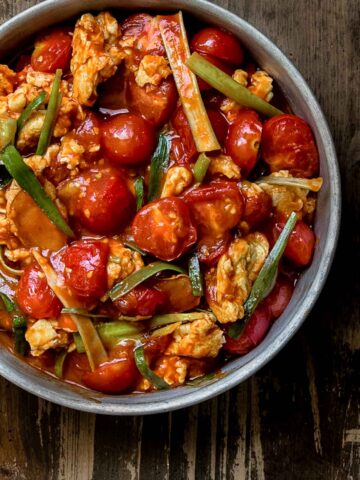
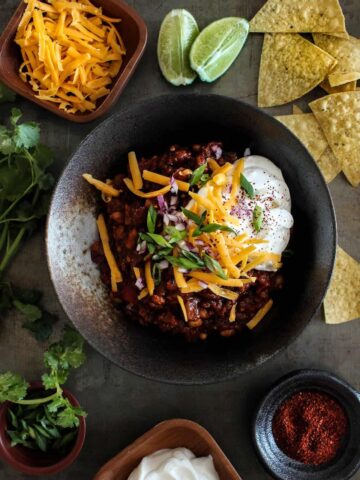
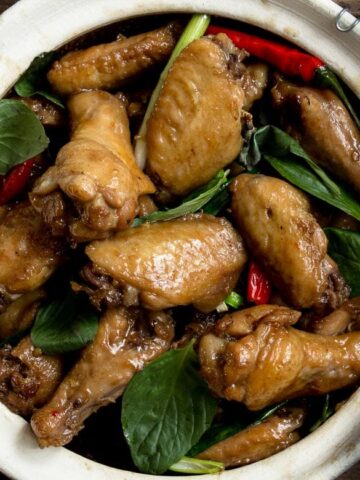
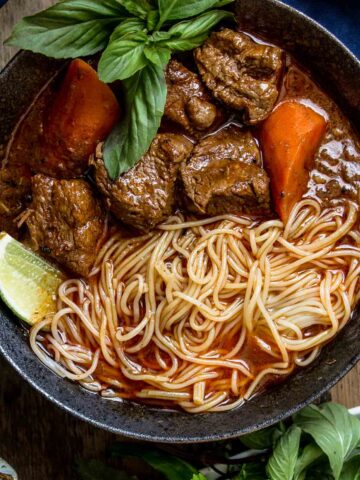
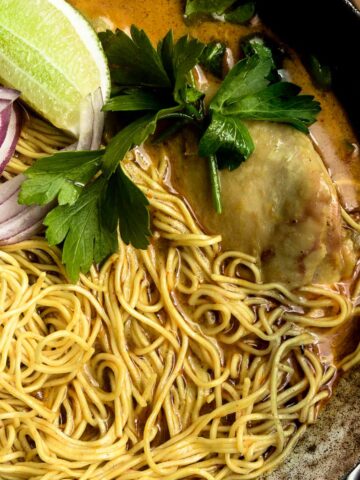
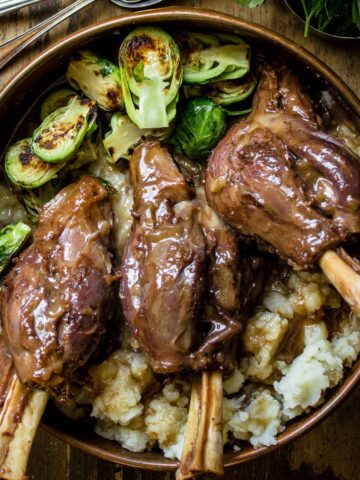

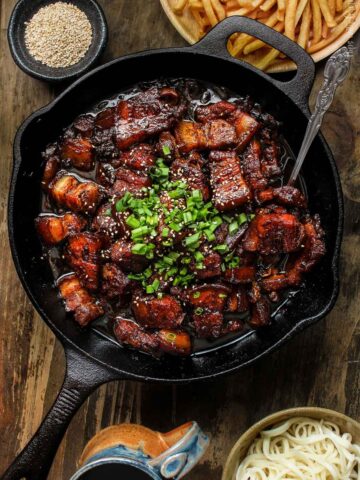
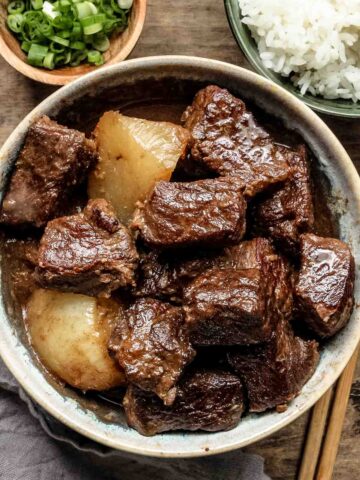
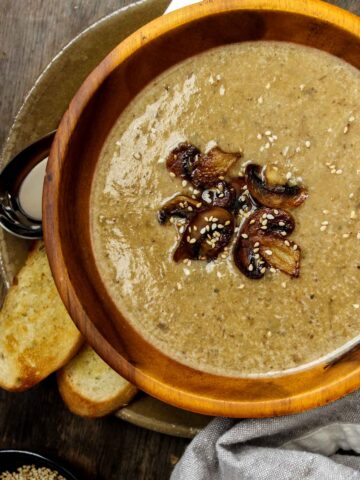
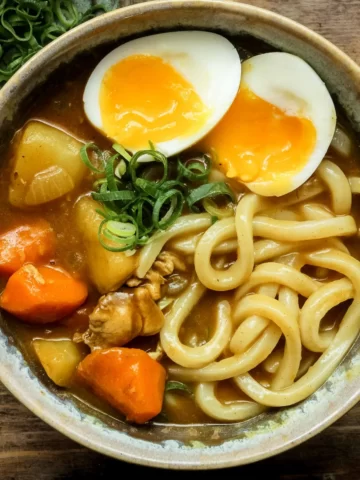
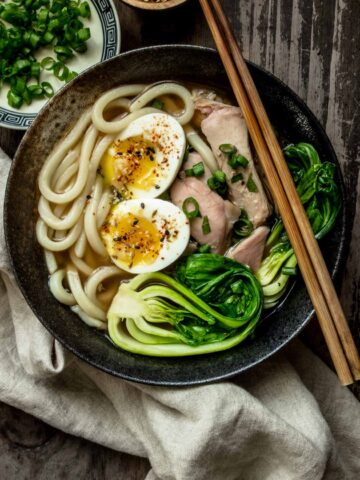
Alyssa @ A Bite of Inspiration says
Joyce, this recipe looks so SO good! I'm a huge fan of kimchi and that broth just sounds so incredibly flavorful. There's a local restaurant my parents used to like to go to for spicy Korean tofu pots, but it closed down recently. Can't wait to make these for them-- they're going to be so excited! Thanks for sharing!
Joyce says
Kimchi makes everything SO flavourful, right? YAY! If you make it for them, I hope they enjoy it!! 🙂
Josie says
This dish is very artistic, colorful and beautiful, with very healthy ingredients. Tofu and the mushrooms are fantastic.
I would follow your recipe to do, to amaze my husband. Thank you, Joyce
Joyce says
I hope he likes it too! 🙂
Erica says
As always, I LOVE learning about new ingredients and techniques from your recipes! Not only does this stew sound amazing, you have made it easy also. I think the longest part of making this dish for myself would be finding all the ingredients (can you come be my personal shopper??) haha. The little mushrooms, those are the enoki mushrooms? They're simply adorable and I want to make this just to have those cute little mushrooms on my kitchen counter! Thanks for another beautifully photographed and detailed recipe, Joyce!
Joyce says
Haha If i was in KC I'd totally go shopping with you! It's actually fun for me! No one ever believes me. Yup those are enoki mushrooms! They go great in soupy things and even omelettes! Definitely a favourite around here. I am so touched and happy to hear you love learning from here. ::blush:: You are too kind! 🙂
mikaela | wyldflour says
I love the step-by-step on this recipe! I'm not gonna lie . . . I see asian food and immediately think it's going to be too difficult. I don't even know WHY--it's just this mental block when I see ingredients that I'm not used to. But your step-by-step breaks it down so well! And it looks so freaking delicious. (And I LOVE spicy tofu.) This stew would be perfect for the upcoming cold front in Denver . . .
Joyce says
Oh haha don't worry Mikaela, I live and breathe asian food and I still get intimidated and confused haha. I am constantly learning new things - there's just SO MUCH things right?
I'm so happy to hear the steps break down helped! I was having a mental breakdown trying to figure out how to easily break this up without confusing everyone and the funny thing is it's not even a very complex recipe! Oh English. Haha! 🙂
Alison @ The Sunday Glutton says
I really appreciate all the detail you've gone into on this post. It's so helpful to understanding and appreciating the dish. I definitely have to check out my local specialty stores - this looks so authentic and delicious!! Hubby is a HUGE kimchi fan, so he'll be happy!
Joyce says
Thanks Alison! I know whenever I have so many ingredients to work with I like to break it down into steps so I'm always happy to hear that it helps others too. It's easy to get overwhelmed in the kitchen and miss steps or ingredients. 🙂 You can even simplify this and omit the silken tofu and just add the kimchi and veg and meats! 🙂
romain | glebekitchen says
I don't think this would be too much work at all. It looks totally worth it to me. I need to take a trip down to the Korean market for some of the ingredients (and one of those dolsot bowls) but that's fun anyway. This is a super informative post. Thanks for putting the time in to teach. It's appreciated! One question - you mention you can substitute pre-fab broth but I didn't see what type of broth?
Joyce says
It is fun isn't it? I still find it fun to just roam around the isles of international supermarkets. 🙂 For the broth you can use any kind and it will turn out just as fantastic. 🙂 and thank you for your kind words Romain.
heather (delicious not gorgeous) says
ooo ? i usually don't get this when i go out for korean because it's too hot and i'm impatient, but this sounds delicious! and i love that you served it with banchan, since that's probably my favorite part of getting korean food.
Joyce says
Banchan is definitely my favourite part of Korean food. The weather here was -20 last week and I simply needed something warm and spicy to take the chill out of my bones lol